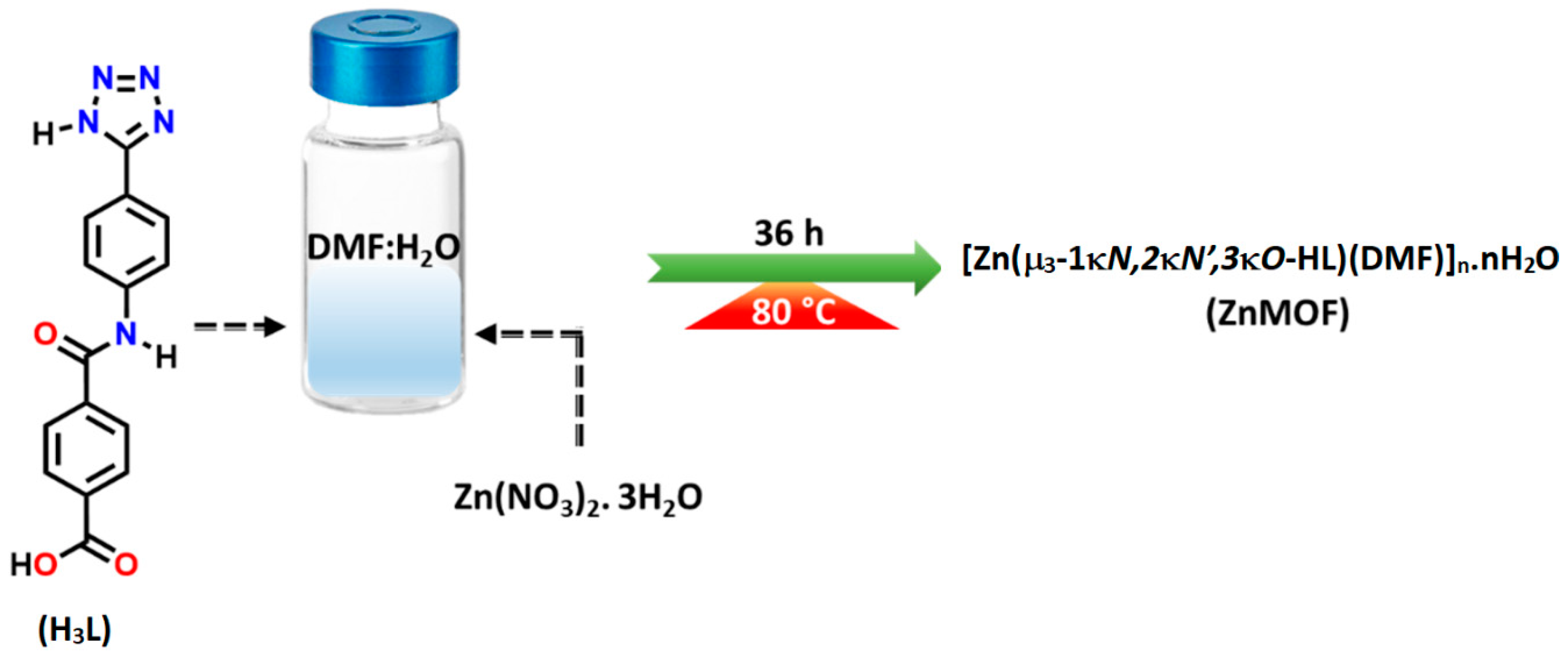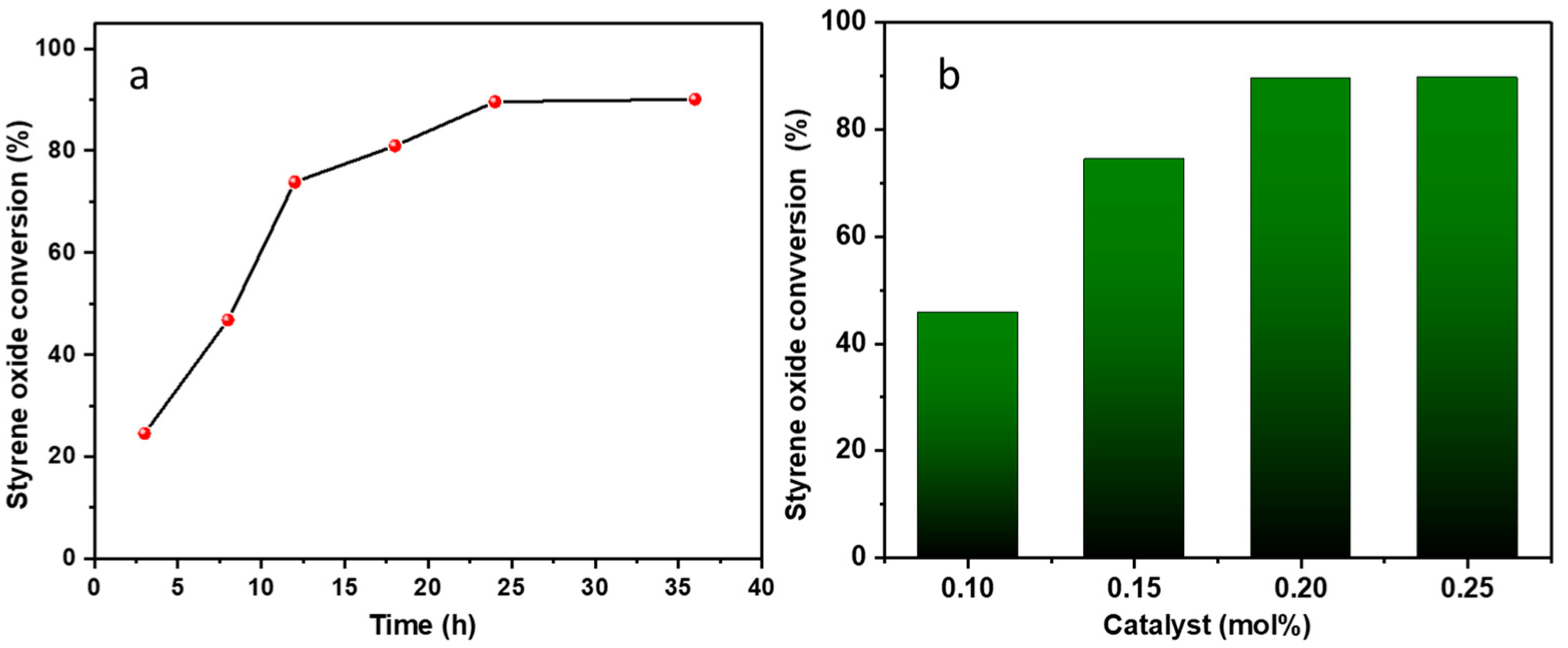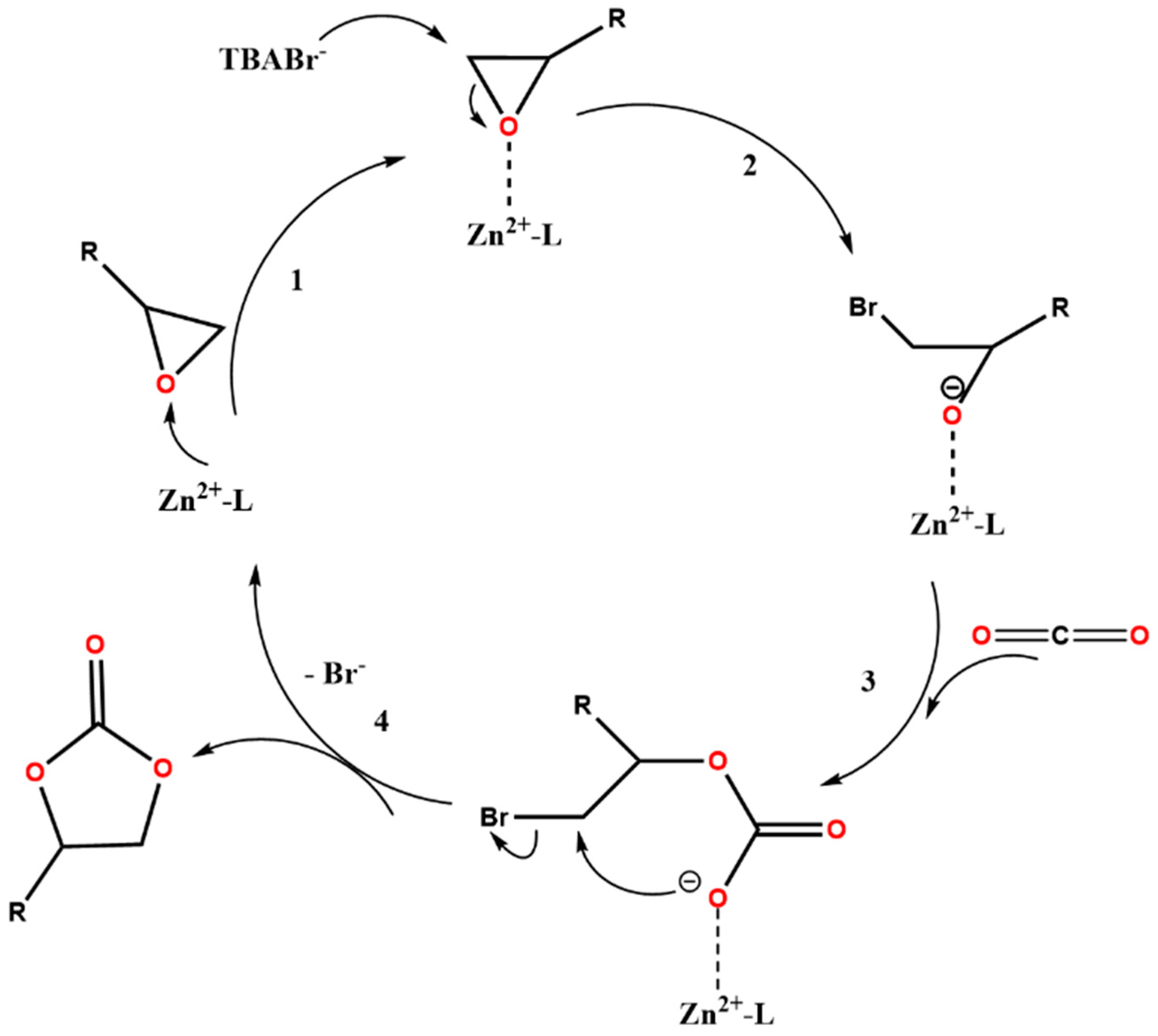Nitrogen-Rich Tetrazole–Amide-Functionalised Zn Metal–Organic Framework as Catalyst for Efficient Catalytic CO2 Cycloaddition with Epoxides
Abstract
:1. Introduction
2. Results and Discussion
2.1. Syntheses and Characterisation
2.2. Crystallographic Analysis of Zn-MOF
2.3. Thermogravimetric Analysis
2.4. BET Surface Area Analysis and Porosity Measurement Using Nitrogen Adsorption-Desorption Isotherm
2.5. Catalytic Studies
3. Synthesis and Characterisation
3.1. Synthesis of 4-((4-(1H-Tetrazol-5-yl)Phenyl)Carbamoyl)Benzoic Acid (H3L)
3.2. Synthesis of [Zn2(μ3-1κN,2κN′,3κO-HL)2(DMF)2]n·nH2O (ZnMOF)
4. Conclusions
Supplementary Materials
Author Contributions
Funding
Data Availability Statement
Conflicts of Interest
References
- Coluccia, M.; Parisse, V.; Guglielmi, P.; Giannini, G.; Secci, D. Metal-Organic Frameworks (MOFs) as Biomolecules Drug Delivery Systems for Anticancer Purposes. Eur. J. Med. Chem. 2022, 244, 114801. [Google Scholar] [CrossRef] [PubMed]
- Dong, A.; Chen, D.; Li, Q.; Qian, J. Metal-Organic Frameworks for Greenhouse Gas Applications. Small 2023, 19, 2201550. [Google Scholar] [CrossRef] [PubMed]
- Wang, J.X.; Yin, J.; Shekhah, O.; Bakr, O.M.; Eddaoudi, M.; Mohammed, O.F. Energy Transfer in Metal-Organic Frameworks for Fluorescence Sensing. ACS Appl. Mater. Interfaces 2022, 14, 9970–9986. [Google Scholar] [CrossRef] [PubMed]
- Li, Y.M.; Hu, J.; Zhu, M. Confining Atomically Precise Nanoclusters in Metal–Organic Frameworks for Advanced Catalysis. Coord. Chem. Rev. 2023, 495, 215364. [Google Scholar] [CrossRef]
- Li, P.Z.; Wang, X.J.; Zhang, K.; Nalaparaju, A.; Zou, R.; Zou, R.; Jiang, J.; Zhao, Y. ‘Click’-Extended Nitrogen-Rich Metal–Organic Frameworks and Their High Performance in CO2-Selective Capture. Chem. Commun. 2014, 50, 4683–4685. [Google Scholar] [CrossRef] [PubMed]
- Cheng, W.C.; Chen, J.M.; Deng, L.; Huang, H.S.; Zhang, J.G.; Zhang, T.L.; Li, Z.M. High-Efficiency Catalysis of Nitrogen-Rich Metal-Organic Frameworks and Their Derivatives for the Thermal Decomposition of Ammonium Perchlorate. Energ. Mater. Front. 2023, 4, 37–43. [Google Scholar] [CrossRef]
- Cao, S.M.; Chen, H.B.; Dong, B.X.; Zheng, Q.H.; Ding, Y.X.; Liu, M.J.; Qian, S.L.; Teng, Y.L.; Li, Z.W.; Liu, W.L. Nitrogen-Rich Metal-Organic Framework Mediated Cu–N–C Composite Catalysts for the Electrochemical Reduction of CO2. J. Energy Chem. 2021, 54, 555–563. [Google Scholar] [CrossRef]
- Guo, C.R.; Ying, Y.M.; Yu, M.; Xiong, Y.; Liu, X.G.; Zhao, Z. Nitrogen-Rich Tetraphenylethene-Based Luminescent Metal-Organic Framework for Efficient Detection of Carcinogens. ACS Omega 2021, 6, 2177–2183. [Google Scholar] [CrossRef]
- Mohan, M.; Essalhi, M.; Durette, D.; Rana, L.K.; Ayevide, F.K.; Maris, T.; Duong, A. A Rational Design of Microporous Nitrogen-Rich Lanthanide Metal-Organic Frameworks for CO2/CH4 Separation. ACS Appl. Mater. Interfaces 2020, 12, 50619–50627. [Google Scholar] [CrossRef]
- Pachfule, P.; Banerjee, R. Porous Nitrogen Rich Cadmium-Tetrazolate Based Metal Organic Framework (MOF) for H2 and CO2 Uptake. Cryst. Growth Des. 2011, 11, 5176–5181. [Google Scholar] [CrossRef]
- Wu, Y.L.; Yang, G.P.; Cheng, S.; Qian, J.; Fan, D.; Wang, Y.Y. Facile Incorporation of Au Nanoparticles into an Unusual Twofold Entangled Zn(II)-MOF with Nanocages for Highly Efficient CO2 Fixation under Mild Conditions. ACS Appl. Mater. Interfaces 2019, 11, 47437–47445. [Google Scholar] [CrossRef] [PubMed]
- Han, C.; Zhang, X.; Huang, S.; Hu, Y.; Yang, Z.; Li, T.T.; Li, Q.; Qian, J. MOF-on-MOF-Derived Hollow Co3O4/In2O3 Nanostructure for Efficient Photocatalytic CO2 Reduction. Adv. Sci. 2023, 10, 2300797. [Google Scholar] [CrossRef] [PubMed]
- Xu, L.; Qiao, J.; Xu, S.; Zhao, X.; Gong, W.; Huang, T. Constructing Strategies and Applications of Nitrogen-Rich Energetic Metal–Organic Framework Materials. Catalysts 2020, 10, 690. [Google Scholar] [CrossRef]
- Zhang, W.; Xu, C.H.; Zheng, H.; Li, R.; Zhou, K. Oxygen-Rich Cobalt–Nitrogen–Carbon Porous Nanosheets for Bifunctional Oxygen Electrocatalysis. Adv. Funct. Mater. 2022, 32, 2200763. [Google Scholar] [CrossRef]
- Chen, C.; Jia, M.; Wang, G.; Li, X.; Li, S. High and Selective CO2 Uptake in a Nitrogen-Rich Pillar-Layered Metal Organic Framework. RSC Adv. 2015, 5, 104932–104935. [Google Scholar] [CrossRef]
- Ji, L.Q.; Yang, J.; Zhang, Z.Y.; Qian, Y.; Su, Z.; Han, M.; Liu, H.K. Enhanced Catalytic Performance for Oxygen Reduction Reaction Derived from Nitrogen-Rich Tetrazolate-Based Heterometallic Metal-Organic Frameworks. Cryst. Growth Des. 2019, 19, 2991–2999. [Google Scholar] [CrossRef]
- Mao, Y.; Wang, Q.; Yu, L.; Qian, H.; Deng, S.; Xiao, W.; Zhao, D.; Chen, C. A 2-Fold Interpenetrated Nitrogen-Rich Metal-Organic Framework for Rapid and Selective Adsorption of Congo Red. Inorg. Chem. 2020, 59, 8213–8219. [Google Scholar] [CrossRef]
- Gao, C.L.; Nie, J.Y. Preferential CO2 Adsorption and Theoretical Simulation of a Cu(II)-Based Metal-Organic Framework with Open-Metal Sites and Basic Groups. Inorg. Chem. Commun. 2019, 102, 199–202. [Google Scholar] [CrossRef]
- Peng, L.L.; Zhou, W.F.; Xu, W.F.; Liu, Y.; Zhou, C.S.; Xie, J.; Tang, K.W. Nitrogen-Rich Covalent Phosphazene-Based Framework for Efficient Removal of Lead(Ii) Ions. New J. Chem. 2023, 47, 6095–6101. [Google Scholar] [CrossRef]
- Xu, J.G.; Yan, Y.F.; Li, X.Z.; Zheng, F.K.; Guo, G.C. A New Sensitive Structural Motif Inlaying the Azides and Tetrazole-Based Rigid 3D Energetic MOFs: Highly Sensitive Primary Explosives with Excellent Thermal Stability. J. Chem. Eng. 2022, 429, 132451. [Google Scholar] [CrossRef]
- Zhang, R.; Meng, D.X.; Ge, F.Y.; Huang, J.H.; Wang, L.F.; Xv, Y.K.; Liu, X.G.; Meng, M.M.; Yan, H.; Lu, Z.Z.; et al. Tetrazole-Based Porous Metal-Organic Frameworks for Selective CO2 Adsorption and Isomerization Studies. Dalton Trans. 2020, 49, 2145–2150. [Google Scholar] [CrossRef] [PubMed]
- Shi, D.; Guo, X.; Lai, T.; Zheng, K.; Wu, Q.; Sun, C.; He, C.; Zhao, J. A Tetrazole-Containing Triphenylamine-Based Metal–Organic Framework: Synthesis and Photocatalytic Oxidative C–C Coupling Reaction. Inorg. Chem. Commun. 2019, 105, 9–12. [Google Scholar] [CrossRef]
- Li, Q.; Yu, M.H.; Xu, J.; Li, A.L.; Hu, T.L.; Bu, X.H. Two New Metal-Organic Frameworks Based on Tetrazole-Heterocyclic Ligands Accompanied by in Situ Ligand Formation. Dalton Trans. 2017, 46, 3223–3228. [Google Scholar] [CrossRef] [PubMed]
- Song, W.C.; Li, J.R.; Song, P.C.; Tao, Y.; Yu, Q.; Tong, X.L.; Bu, X.H. Tuning the Framework Topologies of CoII-Doped Zn II-Tetrazole-Benzoate Coordination Polymers by Ligand Modifications: Structures and Spectral Studies. Inorg. Chem. 2009, 48, 3792–3799. [Google Scholar] [CrossRef] [PubMed]
- Sun, J.Y.; Wang, L.; Zhang, D.J.; Li, D.; Cao, Y.; Zhang, L.Y.; Zeng, S.L.; Pang, G.S.; Fan, Y.; Xu, J.N.; et al. Construction of Metal-Organic Coordination Polymers Derived from 4-Substituted Tetrazole-Benzoate Ligands: Synthesis, Structure, Luminescence, and Magnetic Behaviors. CrystEngComm 2013, 15, 3402–3411. [Google Scholar] [CrossRef]
- Ordonez, C.; Kinnibrugh, T.L.; Xu, H.; Lindline, J.; Timofeeva, T.; Wei, Q. Synthesis of Framework Isomer MOFs Containing Zinc and 4-Tetrazolyl Benzenecarboxylic Acid via a Structure Directing Solvothermal Approach. Crystals 2015, 5, 193–205. [Google Scholar] [CrossRef]
- Li, Y.; Xu, G.; Zou, W.Q.; Wang, M.S.; Zheng, F.K.; Wu, M.F.; Zeng, H.Y.; Guo, G.C.; Huang, J.S. A Novel Metal-Organic Network with High Thermal Stability: Nonlinear Optical and Photoluminescent Properties. Inorg. Chem. 2008, 47, 7945–7947. [Google Scholar] [CrossRef]
- Paul, A.; Karmakar, A.; Guedes da Silva, M.F.C.; Pombeiro, A.J.L. Amide Functionalized Metal-Organic Frameworks for Diastereoselective Nitroaldol (Henry) Reaction in Aqueous Medium. RSC Adv. 2015, 5, 87400–87410. [Google Scholar] [CrossRef]
- Paul, A.; Das, K.; Karmakar, A.; Guedes Da Silva, M.F.C.; Pombeiro, A.J.L. A Mechanistic Insight into the Rapid and Selective Removal of Congo Red by an Amide Functionalised Zn(II) Coordination Polymer. Dalton Trans. 2020, 49, 12970–12984. [Google Scholar] [CrossRef]
- Karmakar, A.; Paul, A.; Rúbio, G.M.D.M.; Soliman, M.M.A.; Guedes da Silva, M.F.C.; Pombeiro, A.J.L. Highly Efficient Bifunctional Amide Functionalized Zn and Cd Metal Organic Frameworks for One-Pot Cascade Deacetalization–Knoevenagel Reactions. Front. Chem. 2019, 7, 699. [Google Scholar] [CrossRef]
- Paul, A.; Martins, L.M.D.R.S.; Karmakar, A.; Kuznetsov, M.L.; C Guedes da Silva, M.F.; Pombeiro, A.J.L. Zn(II)-to-Cu(II) Transmetalation in an Amide Functionalized Complex and Catalytic Applications in Styrene Oxidation and Nitroaldol Coupling. Molecules 2020, 25, 2644. [Google Scholar] [CrossRef] [PubMed]
- Paul, A.; Martins, L.M.D.R.S.; Karmakar, A.; Kuznetsov, M.L.; Novikov, A.S.; Guedes da Silva, M.F.C.; Pombeiro, A.J.L. Environmentally Benign Benzyl Alcohol Oxidation and C–C Coupling Catalysed by Amide Functionalized 3D Co(II) and Zn(II) Metal Organic Frameworks. J. Catal. 2020, 385, 324–337. [Google Scholar] [CrossRef]
- Paul, A.; Upadhyay, K.K.; Backović, G.; Karmakar, A.; Vieira Ferreira, L.F.; Šljukić, B.; Montemor, M.F.; Guedes Da Silva, M.F.C.; Pombeiro, A.J.L. Versatility of Amide-Functionalized Co(II) and Ni(II) Coordination Polymers: From Thermochromic-Triggered Structural Transformations to Supercapacitors and Electrocatalysts for Water Splitting. Inorg. Chem. 2020, 59, 16301–16318. [Google Scholar] [CrossRef] [PubMed]
- Fan, S.C.; Li, Y.T.; Wang, Y.; Wang, J.W.; Xue, Y.Y.; Li, H.P.; Li, S.N.; Zhai, Q.G. Amide-Functionalized Metal-Organic Frameworks Coupled with Open Fe/Sc Sites for Efficient Acetylene Purification. Inorg. Chem. 2021, 60, 18473–18482. [Google Scholar] [CrossRef] [PubMed]
- Lin, Y.; Kong, C.; Chen, L. Amine-Functionalized Metal-Organic Frameworks: Structure, Synthesis and Applications. RSC Adv. 2016, 6, 32598–32614. [Google Scholar] [CrossRef]
- Moi, R.; Nath, K.; Ghosh, D.; Biradha, K. Metal-Organic Gels of Tris-Tetrazole-tri-Amido Molecule with Co(II) and Ni(II) as Electrocatalysts for OER: Effect of Metal Ion, Porosity and Morphology on the Catalysis of MOGs. ChemCatChem 2023, 15, e202300694. [Google Scholar] [CrossRef]
- Zhou, L.; Xue, Y.S.; Xu, Y.; Zhang, J.; Du, H. Bin Two Photoluminescent Metal-Organic Frameworks Based on a BODIPY-Derived Bipyridine Ligand. CrystEngComm 2013, 15, 7315–7320. [Google Scholar] [CrossRef]
- Peedikakkal, A.M.P.; Aljund, I.H. Upgrading the Hydrogen Storage of Mof-5 by Post-Synthetic Exchange with Divalent Metal Ions. Appl. Sci. 2021, 11, 11687. [Google Scholar] [CrossRef]
- Yang, L.; Powell, D.R.; Houser, R.P. Structural Variation in Copper(I) Complexes with Pyridylmethylamide Ligands: Structural Analysis with a New Four-Coordinate Geometry Index, Τ4. Dalton Trans. 2007, 9, 955–964. [Google Scholar] [CrossRef]
- Ambroz, F.; Macdonald, T.J.; Martis, V.; Parkin, I.P. Evaluation of the BET Theory for the Characterization of Meso and Microporous MOFs. Small Methods 2018, 2, 1800173. [Google Scholar] [CrossRef]
- Babu, R.; Roshan, R.; Kathalikkattil, A.C.; Kim, D.W.; Park, D.W. Rapid, Microwave-Assisted Synthesis of Cubic, Three-Dimensional, Highly Porous MOF-205 for Room Temperature CO2 Fixation via Cyclic Carbonate Synthesis. ACS Appl. Mater. Interfaces 2016, 8, 33723–33731. [Google Scholar] [CrossRef] [PubMed]
- Kathalikkattil, A.C.; Roshan, R.; Tharun, J.; Babu, R.; Jeong, G.S.; Kim, D.W.; Cho, S.J.; Park, D.W. A Sustainable Protocol for the Facile Synthesis of Zinc-Glutamate MOF: An Efficient Catalyst for Room Temperature CO2 Fixation Reactions under Wet Conditions. Chem. Commun. 2016, 52, 280–283. [Google Scholar] [CrossRef] [PubMed]
- Patel, P.; Parmar, B.; Kureshy, R.I.; Khan, N.U.H.; Suresh, E. Amine-Functionalized Zn(II) MOF as an Efficient Multifunctional Catalyst for CO2 Utilization and Sulfoxidation Reaction. Dalton Trans. 2018, 47, 8041–8051. [Google Scholar] [CrossRef] [PubMed]
- Guo, L.; Lamb, K.J.; North, M. Recent Developments in Organocatalysed Transformations of Epoxides and Carbon Dioxide into Cyclic Carbonates. Green. Chem. 2021, 23, 77–118. [Google Scholar] [CrossRef]
- Maia, R.A.; Louis, B.; Gao, W.; Wang, Q. CO2 adsorption Mechanisms on MOFs: A Case Study of Open Metal Sites, Ultra-Microporosity and Flexible Framework. React. Chem. Eng. 2021, 6, 1118–1133. [Google Scholar] [CrossRef]
- Janeta, M.; Lis, T.; Szafert, S. Zinc Imine Polyhedral Oligomeric Silsesquioxane as a Quattro-Site Catalyst for the Synthesis of Cyclic Carbonates from Epoxides and Low-Pressure CO2. Chem.—Eur. J. 2020, 26, 13686–13697. [Google Scholar] [CrossRef] [PubMed]
- Kuznetsova, S.A.; Rulev, Y.A.; Larionov, V.A.; Smol’yakov, A.F.; Zubavichus, Y.V.; Maleev, V.I.; Li, H.; North, M.; Saghyan, A.S.; Belokon, Y.N. Self-Assembled Ionic Composites of Negatively Charged Zn(Salen) Complexes and Triphenylmethane Derived Polycations as Recyclable Catalysts for the Addition of Carbon Dioxide to Epoxides. ChemCatChem 2019, 11, 511–519. [Google Scholar] [CrossRef]
- Li, Y.; Zhang, X.; Lan, J.; Xu, P.; Sun, J. Porous Zn(Bmic)(AT) MOF with Abundant Amino Groups and Open Metal Sites for Efficient Capture and Transformation of CO2. Inorg. Chem. 2019, 58, 13917–13926. [Google Scholar] [CrossRef]
- Kurisingal, J.F.; Rachuri, Y.; Gu, Y.; Choe, Y.; Park, D.W. Multi-Variate Metal Organic Framework as Efficient Catalyst for the Cycloaddition of CO2 and Epoxides in a Gas-Liquid-Solid Reactor. J. Chem. Eng. 2020, 386, 121700. [Google Scholar] [CrossRef]
- Lan, J.; Qu, Y.; Zhang, X.; Ma, H.; Xu, P.; Sun, J. A Novel Water-Stable MOF Zn(Py)(Atz) as Heterogeneous Catalyst for Chemical Conversion of CO2 with Various Epoxides under Mild Conditions. J. CO2 Util. 2020, 35, 216–224. [Google Scholar] [CrossRef]
- Li, Y.; Zhang, X.; Lan, J.; Li, D.; Wang, Z.; Xu, P.; Sun, J. A High-Performance Zinc-Organic Framework with Accessible Open Metal Sites Catalyzes CO2 and Styrene Oxide into Styrene Carbonate under Mild Conditions. ACS Sustain. Chem. Eng. 2021, 9, 2795–2803. [Google Scholar] [CrossRef]
- Bondarenko, G.N.; Ganina, O.G.; Lysova, A.A.; Fedin, V.P.; Beletskaya, I.P. Cyclic Carbonates Synthesis from Epoxides and CO2 over NIIC-10 Metal-Organic Frameworks. J. CO2 Util. 2021, 53, 101718. [Google Scholar] [CrossRef]
- Li, H.J.; Zhang, X.Y.; Huang, K.; Qin, D. Bin A Novel 2D Zinc(II)-Organic Framework for Efficient Catalytic Cycloaddition of CO2 with Epoxides. Polyhedron 2022, 220, 115850. [Google Scholar] [CrossRef]
- Bruker. APEX2; Bruker AXS Inc.: Madison, WI, USA, 2012. [Google Scholar]
- Sheldrick, G.M. SADABS Program for Empirical Absorption Correction; University of Gottingen: Göttingen, Germany, 2000. [Google Scholar] [CrossRef]
- Sheldrick, G.M. Crystal Structure Refinement with SHELXL. Acta Crystallogr. C Struct. Chem. 2015, 71, 3–8. [Google Scholar] [CrossRef]
- Farrugia, L.J. WinGX and ORTEP for Windows: An Update. J. Appl. Crystallogr. 2012, 45, 849–854. [Google Scholar] [CrossRef]







| Entry | Catalyst | Time (h) | Catalyst Amount (mol%) | CO2 Pressure (MPa) | T (°C) | Conversion a (%) |
|---|---|---|---|---|---|---|
| 1 | ZnMOF b | 24 | 0.20 | 4 | 60 | 89.6 |
| 2 | ZnMOF b | 3 | 0.20 | 4 | 60 | 24.5 |
| 3 | ZnMOF b | 8 | 0.20 | 4 | 60 | 46.8 |
| 4 | ZnMOF b | 12 | 0.20 | 4 | 60 | 73.8 |
| 5 | ZnMOF b | 18 | 0.20 | 4 | 60 | 80.9 |
| 6 | ZnMOF b | 24 | 0.20 | 4 | 60 | 89.6 |
| 7 | ZnMOF b | 36 | 0.20 | 4 | 60 | 90.0 |
| 8 | ZnMOF b | 24 | 0.00 | 4 | 60 | 14.9 |
| 9 | ZnMOF b | 24 | 0.10 | 4 | 60 | 45.7 |
| 10 | ZnMOF b | 24 | 0.15 | 4 | 60 | 74.5 |
| 11 | ZnMOF b | 24 | 0.20 | 4 | 60 | 89.6 |
| 12 | ZnMOF b | 24 | 0.25 | 4 | 60 | 89.7 |
| 13 | ZnMOF b | 24 | 0.20 | 4 | 40 | 79.2 |
| 14 | ZnMOF b | 24 | 0.20 | 4 | 60 | 89.6 |
| 15 | ZnMOF b | 24 | 0.20 | 4 | 80 | 90.0 |
| 16 | ZnMOF b | 24 | 0.20 | 3 | 60 | 82.2 |
| 17 | ZnMOF b | 24 | 0.20 | 4 | 60 | 89.6 |
| 18 | ZnMOF b | 24 | 0.20 | 6 | 60 | 90.3 |
| 19 | Zn(NO3)2·6H2O b | 24 | 0.20 | 4 | 60 | 51.5 |
| 20 | H3L b | 24 | 0.20 | 4 | 60 | 15.6 |
| 21 | ZnMOF c | 24 | 0.20 | 4 | 60 | 38.4 |
| 22 | ZnMOF d | 24 | 0.20 | 4 | 60 | 73.7 |
| 23 | ZnMOF b | 24 | 0.20 | 4 | 60 | 89.6 |
| 24 | ZnMOF e | 24 | 0.20 | 4 | 60 | 9.0 |
| Entry | Substrate | Epoxide Conversion (%) b |
|---|---|---|
| 1 |  | 99.4 |
| 2 |  | 98.2 |
| 3 |  | 89.9 |
| 4 |  | 80.8 |
| 5 |  | 16.9 |
| Catalyst | Zn (mol%) | TBABr (mol%) | T (°C) | p (MPa) | Time (h) | TOF (h−1) | Reference |
|---|---|---|---|---|---|---|---|
| ZnMOF | 0.4 | 0.4 | 60 | 4.0 | 3 | 21 | This work |
| Zn4@POSS-1 | 1.0 | 4.0 | 100 | 0.1 | 4 | 10 | [46] |
| Zn(salen) | 2.0 | - | 50 | 5.0 | 24 | 1 | [47] |
| MOF-205(M) | 2.4 | 0.6 | Rt | 1.2 | 24 | 2 | [41] |
| ZnMOF-1-NH2 | 1.0 | 2.5 | 60 | 0.8 | 6 | 13 | [43] |
| Zn(Bmic)(AT) | 0.5 | 1.5 | 90 | 0.5 | 6 | 26 | [48] |
| MOF-5-MIX | 0.5 | 0.5 | 50 | 1.2 | 6 | 18 | [49] |
| Zn(Py)(Atz) | 0.6 | 0.9 | 60 | 1.5 | 24 | 5 | [50] |
| Zn-2PDC | 0.5 | 3.5 | 55 | 1.0 | 4 | 29 | [51] |
| NIIC-10-Pr | 2.0 | 1.5 | 80 | 0.2 | 20 | 2 | [52] |
| Zn(dibpca)(OAc) | 0.1 | 2.5 | 80 | 0.1 | 10 | 70 | [53] |
Disclaimer/Publisher’s Note: The statements, opinions and data contained in all publications are solely those of the individual author(s) and contributor(s) and not of MDPI and/or the editor(s). MDPI and/or the editor(s) disclaim responsibility for any injury to people or property resulting from any ideas, methods, instructions or products referred to in the content. |
© 2023 by the authors. Licensee MDPI, Basel, Switzerland. This article is an open access article distributed under the terms and conditions of the Creative Commons Attribution (CC BY) license (https://creativecommons.org/licenses/by/4.0/).
Share and Cite
Paul, A.; Garazade, I.M.; Karmakar, A.; Khan, R.A.; Guedes da Silva, M.F.C.; Nunes, A.V.M.; Pombeiro, A.J.L. Nitrogen-Rich Tetrazole–Amide-Functionalised Zn Metal–Organic Framework as Catalyst for Efficient Catalytic CO2 Cycloaddition with Epoxides. Catalysts 2024, 14, 6. https://doi.org/10.3390/catal14010006
Paul A, Garazade IM, Karmakar A, Khan RA, Guedes da Silva MFC, Nunes AVM, Pombeiro AJL. Nitrogen-Rich Tetrazole–Amide-Functionalised Zn Metal–Organic Framework as Catalyst for Efficient Catalytic CO2 Cycloaddition with Epoxides. Catalysts. 2024; 14(1):6. https://doi.org/10.3390/catal14010006
Chicago/Turabian StylePaul, Anup, Ismayil M. Garazade, Anirban Karmakar, Rais Ahmad Khan, Maria Fátima C. Guedes da Silva, Ana V. M. Nunes, and Armando J. L. Pombeiro. 2024. "Nitrogen-Rich Tetrazole–Amide-Functionalised Zn Metal–Organic Framework as Catalyst for Efficient Catalytic CO2 Cycloaddition with Epoxides" Catalysts 14, no. 1: 6. https://doi.org/10.3390/catal14010006
APA StylePaul, A., Garazade, I. M., Karmakar, A., Khan, R. A., Guedes da Silva, M. F. C., Nunes, A. V. M., & Pombeiro, A. J. L. (2024). Nitrogen-Rich Tetrazole–Amide-Functionalised Zn Metal–Organic Framework as Catalyst for Efficient Catalytic CO2 Cycloaddition with Epoxides. Catalysts, 14(1), 6. https://doi.org/10.3390/catal14010006









